2011 Hyundai Santa Fe fuel
[x] Cancel search: fuelPage 268 of 312
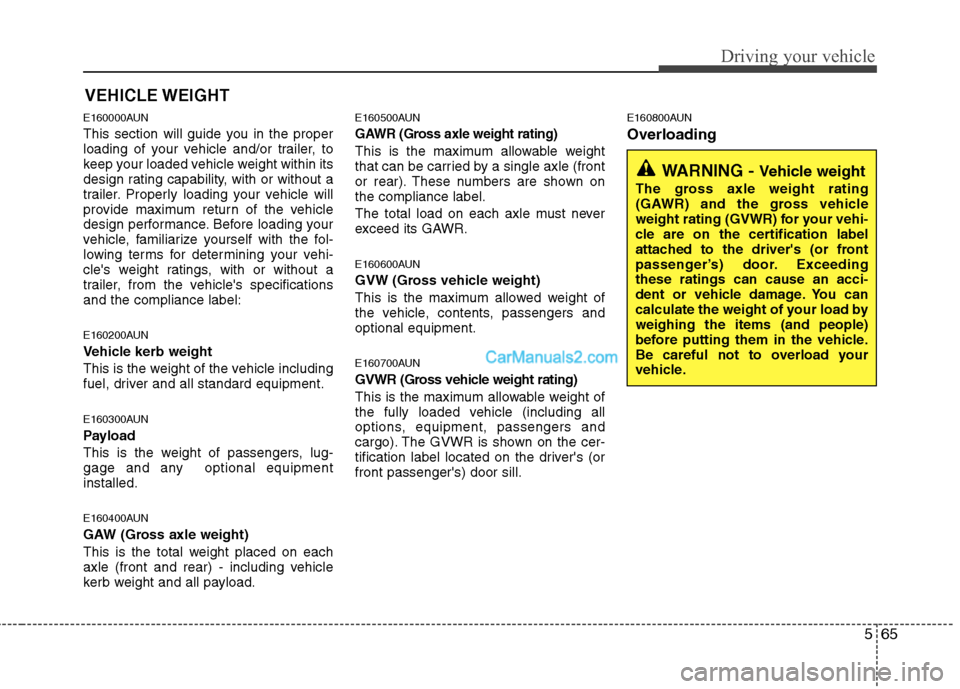
565
Driving your vehicle
E160000AUN
This section will guide you in the proper
loading of your vehicle and/or trailer, to
keep your loaded vehicle weight within its
design rating capability, with or without a
trailer. Properly loading your vehicle will
provide maximum return of the vehicle
design performance. Before loading your
vehicle, familiarize yourself with the fol-
lowing terms for determining your vehi-
cle's weight ratings, with or without a
trailer, from the vehicle's specificationsand the compliance label:
E160200AUN
Vehicle kerb weight
This is the weight of the vehicle including
fuel, driver and all standard equipment.
E160300AUN
Payload
This is the weight of passengers, lug-
gage and any optional equipmentinstalled.
E160400AUN
GAW (Gross axle weight)
This is the total weight placed on each
axle (front and rear) - including vehicle
kerb weight and all payload.E160500AUN
GAWR (Gross axle weight rating)
This is the maximum allowable weight
that can be carried by a single axle (front
or rear). These numbers are shown onthe compliance label.
The total load on each axle must never
exceed its GAWR.
E160600AUN
GVW (Gross vehicle weight)
This is the maximum allowed weight of
the vehicle, contents, passengers andoptional equipment.
E160700AUN
GVWR (Gross vehicle weight rating)
This is the maximum allowable weight of
the fully loaded vehicle (including all
options, equipment, passengers and
cargo). The GVWR is shown on the cer-
tification label located on the driver's (orfront passenger's) door sill.
E160800AUN Overloading
VEHICLE WEIGHT
WARNING -
Vehicle weight
The gross axle weight rating
(GAWR) and the gross vehicle
weight rating (GVWR) for your vehi-
cle are on the certification label
attached to the driver's (or front
passenger’s) door. Exceedingthese ratings can cause an acci-
dent or vehicle damage. You can
calculate the weight of your load byweighing the items (and people)
before putting them in the vehicle.
Be careful not to overload your
vehicle.
Page 272 of 312
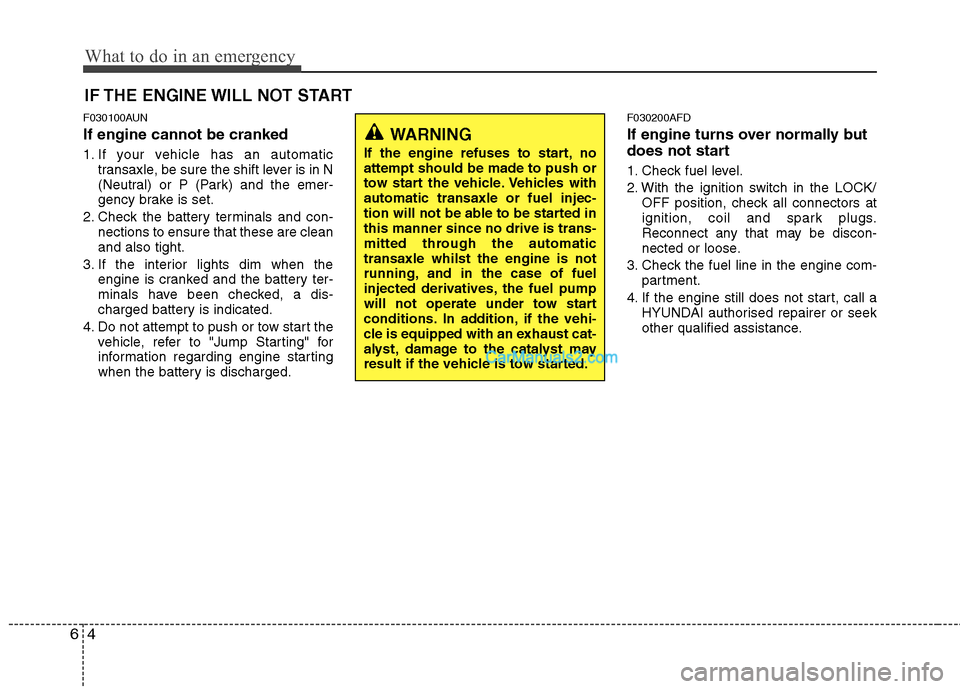
What to do in an emergency
4
6
IF THE ENGINE WILL NOT START
F030100AUN If engine cannot be cranked
1. If your vehicle has an automatic transaxle, be sure the shift lever is in N
(Neutral) or P (Park) and the emer-
gency brake is set.
2. Check the battery terminals and con- nections to ensure that these are cleanand also tight.
3. If the interior lights dim when the engine is cranked and the battery ter-
minals have been checked, a dis-
charged battery is indicated.
4. Do not attempt to push or tow start the vehicle, refer to "Jump Starting" for
information regarding engine starting
when the battery is discharged. F030200AFD
If engine turns over normally but
does not start
1. Check fuel level.
2. With the ignition switch in the LOCK/
OFF position, check all connectors at
ignition, coil and spark plugs.
Reconnect any that may be discon-
nected or loose.
3. Check the fuel line in the engine com- partment.
4. If the engine still does not start, call a HYUNDAI authorised repairer or seek
other qualified assistance.
WARNING
If the engine refuses to start, no attempt should be made to push or
tow start the vehicle. Vehicles withautomatic transaxle or fuel injec-
tion will not be able to be started inthis manner since no drive is trans-
mitted through the automatictransaxle whilst the engine is not
running, and in the case of fuel
injected derivatives, the fuel pump
will not operate under tow start
conditions. In addition, if the vehi-
cle is equipped with an exhaust cat-
alyst, damage to the catalyst may
result if the vehicle is tow started.
Page 276 of 312
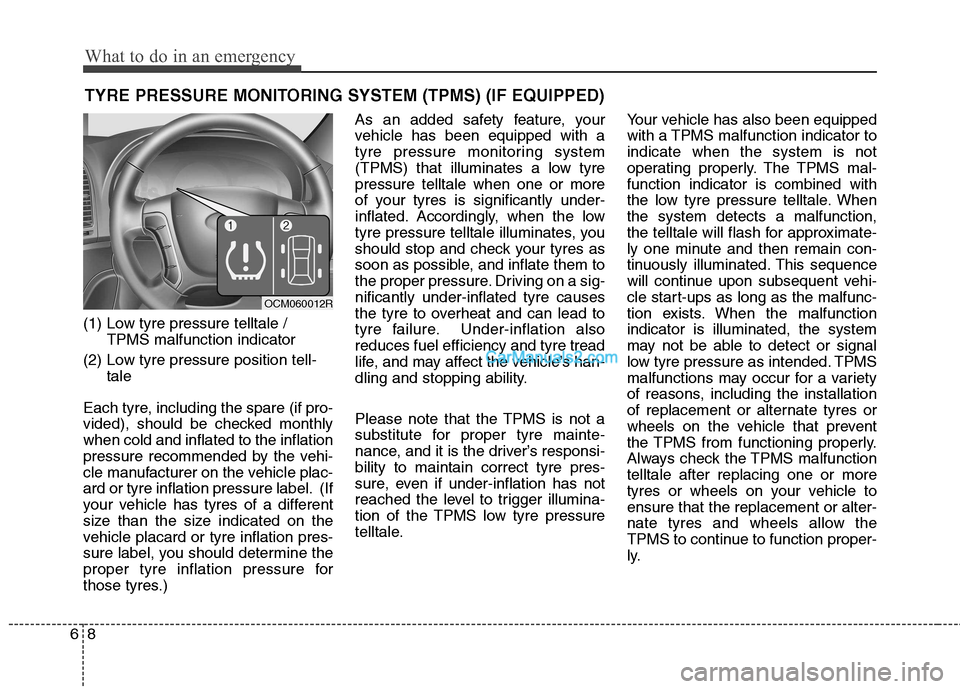
What to do in an emergency
8
6
TYRE PRESSURE MONITORING SYSTEM (TPMS) (IF EQUIPPED)
(1) Low tyre pressure telltale / TPMS malfunction indicator
(2) Low tyre pressure position tell- tale
Each tyre, including the spare (if pro-
vided), should be checked monthlywhen cold and inflated to the inflation
pressure recommended by the vehi-
cle manufacturer on the vehicle plac-
ard or tyre inflation pressure label. (If
your vehicle has tyres of a different
size than the size indicated on the
vehicle placard or tyre inflation pres-
sure label, you should determine the
proper tyre inflation pressure for
those tyres.) As an added safety feature, your
vehicle has been equipped with a
tyre pressure monitoring system
(TPMS) that illuminates a low tyrepressure telltale when one or more
of your tyres is significantly under-
inflated. Accordingly, when the low
tyre pressure telltale illuminates, you
should stop and check your tyres as
soon as possible, and inflate them to
the proper pressure. Driving on a sig-nificantly under-inflated tyre causes
the tyre to overheat and can lead to
tyre failure. Under-inflation alsoreduces fuel efficiency and tyre tread
life, and may affect the vehicle’s han-
dling and stopping ability.
Please note that the TPMS is not a
substitute for proper tyre mainte-
nance, and it is the driver’s responsi-bility to maintain correct tyre pres-
sure, even if under-inflation has not
reached the level to trigger illumina-
tion of the TPMS low tyre pressure
telltale.
Your vehicle has also been equipped
with a TPMS malfunction indicator toindicate when the system is not
operating properly. The TPMS mal-function indicator is combined with
the low tyre pressure telltale. Whenthe system detects a malfunction,
the telltale will flash for approximate-
ly one minute and then remain con-
tinuously illuminated. This sequence
will continue upon subsequent vehi-
cle start-ups as long as the malfunc-
tion exists. When the malfunctionindicator is illuminated, the system
may not be able to detect or signal
low tyre pressure as intended. TPMS
malfunctions may occur for a variety
of reasons, including the installation
of replacement or alternate tyres or
wheels on the vehicle that prevent
the TPMS from functioning properly.
Always check the TPMS malfunctiontelltale after replacing one or more
tyres or wheels on your vehicle toensure that the replacement or alter-
nate tyres and wheels allow the
TPMS to continue to function proper-
ly.
OCM060012R
Page 298 of 312
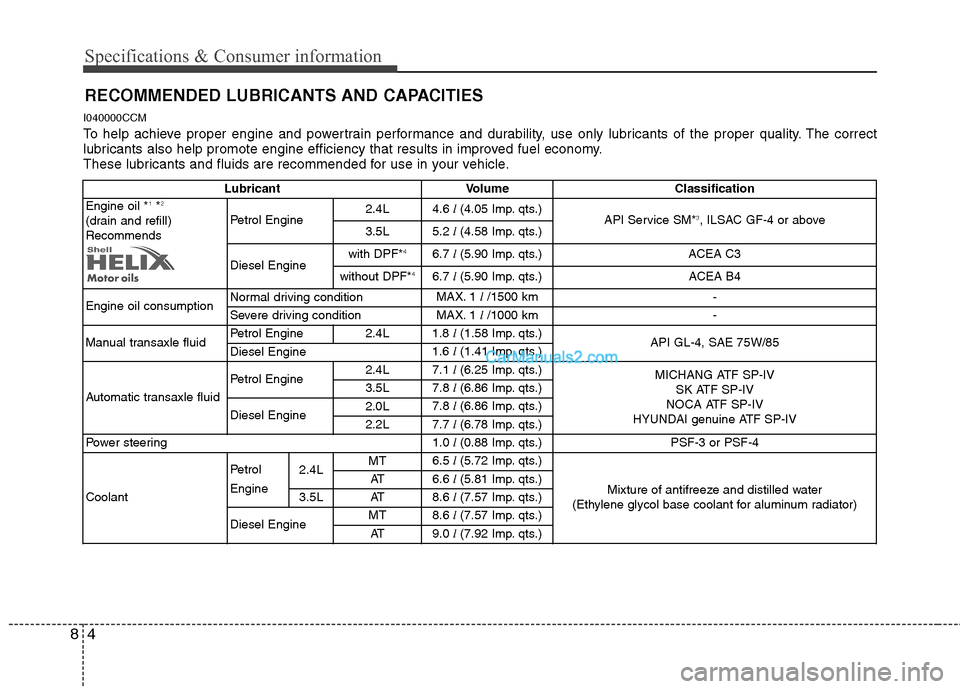
Specifications & Consumer information
4
8
RECOMMENDED LUBRICANTS AND CAPACITIES
I040000CCM
To help achieve proper engine and powertrain performance and durability, use only lubricants of the proper quality. The correct
lubricants also help promote engine efficiency that results in improved fuel economy.
These lubricants and fluids are recommended for use in your vehicle.
Lubricant Volume Classification
Engine oil * 1
*2
(drain and refill) Recommends Petrol Engine
2.4L
4.6
l (4.05 Imp. qts.)
API Service SM*3
, ILSAC GF-4 or above
3.5L 5.2
l (4.58 Imp. qts.)
Diesel Engine with DPF*
4
6.7 l (5.90 Imp. qts.)
ACEA C3
without DPF* 4
6.7 l (5.90 Imp. qts.)
ACEA B4
Engine oil consumption Normal driving condition
MAX. 1
l/1500 km
-
Severe driving condition MAX. 1
l/1000 km
-
Manual transaxle fluid Petrol Engine 2.4L
1.8
l(1.58 Imp. qts.)
API GL-4, SAE 75W/85
Diesel Engine 1.6
l(1.41 Imp. qts.)
Automatic transaxle fluid Petrol Engine
2.4L
7.1
l (6.25 Imp. qts.)
MICHANG ATF SP-IV
SK ATF SP-IV
NOCA ATF SP-IV
HYUNDAI genuine ATF SP-IV
3.5L
7.8
l (6.86 Imp. qts.)
Diesel Engine 2.0L
7.8
l (6.86 Imp. qts.)
2.2L 7.7
l (6.78 Imp. qts.)
Power steering 1.0
l (0.88 Imp. qts.)
PSF-3 or PSF-4
Coolant Petrol Engine
2.4L
MT
6.5
l (5.72 Imp. qts.)
Mixture of antifreeze and distilled water
(Ethylene glycol base coolant for aluminum radiator)
AT
6.6
l (5.81 Imp. qts.)
3.5L AT 8.6
l (7.57 Imp. qts.)
Diesel Engine MT
8.6
l (7.57 Imp. qts.)
AT 9.0
l (7.92 Imp. qts.)
Page 299 of 312
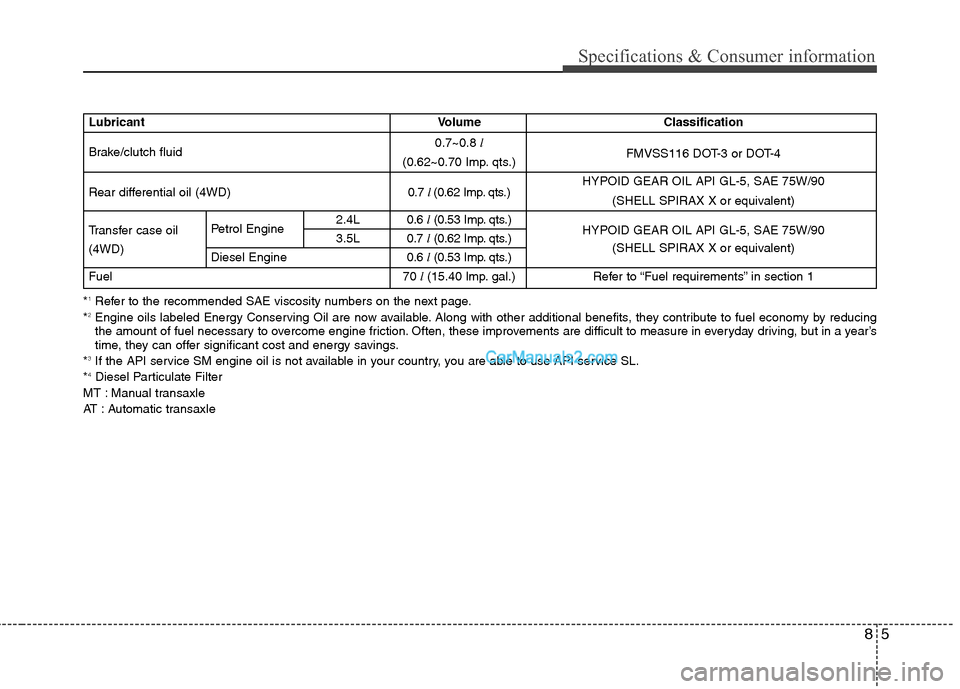
85
Specifications & Consumer information
LubricantVolume Classification
Brake/clutch fluid 0.7~0.8
l
FMVSS116 DOT-3 or DOT-4
(0.62~0.70 Imp. qts.)
Rear differential oil (4WD) 0.7 l (0.62 Imp. qts.) HYPOID GEAR OIL API GL-5, SAE 75W/90
(SHELL SPIRAX X or equivalent)
Transfer case oil Petrol Engine 2.4L 0.6
l (0.53 Imp. qts.)
HYPOID GEAR OIL API GL-5, SAE 75W/90
(4WD) 3.5L 0.7
l (0.62 Imp. qts.)
Diesel Engine 0.6 l (0.53 Imp. qts.) (SHELL SPIRAX X or equivalent)
Fuel 70 l (15.40 lmp. gal.) Refer to “Fuel requirements” in section 1
*1
Refer to the recommended SAE viscosity numbers on the next page.
* 2
Engine oils labeled Energy Conserving Oil are now available. Along with other additional benefits, they contribute to fuel economy by reducing
the amount of fuel necessary to overcome engine friction. Often, these improvements are difficult to measure in everyday driving, but in a year’s
time, they can offer significant cost and energy savings.
* 3
If the API service SM engine oil is not available in your country, you are able to use API service SL.
* 4
Diesel Particulate Filter
MT : Manual transaxle
AT : Automatic transaxle
Page 300 of 312
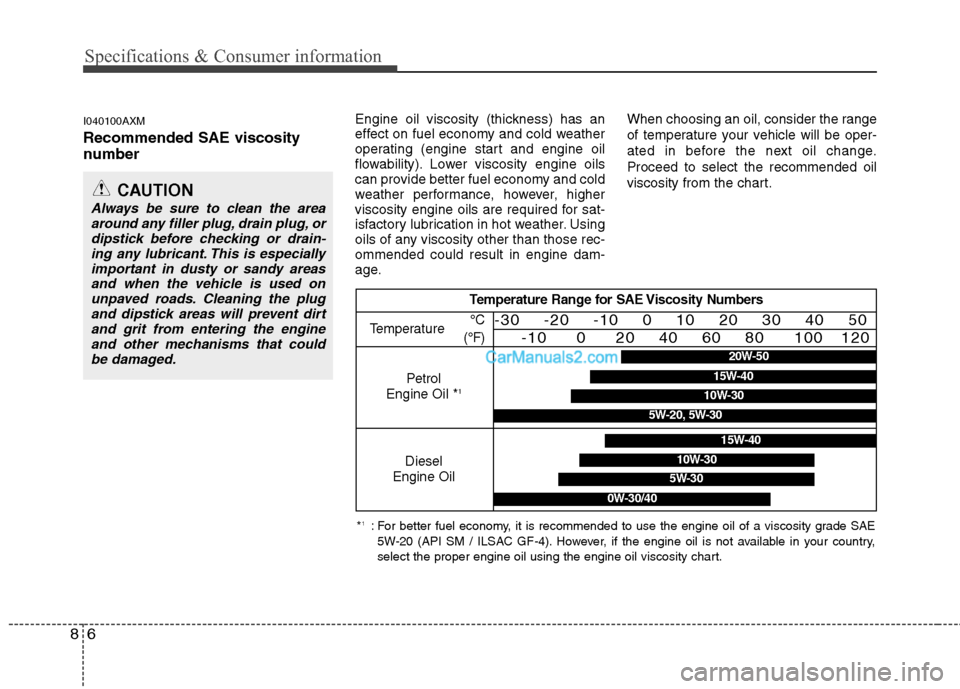
Specifications & Consumer information
6
8
I040100AXM Recommended SAE viscosity
number Engine oil viscosity (thickness) has an
effect on fuel economy and cold weather
operating (engine start and engine oil
flowability). Lower viscosity engine oils
can provide better fuel economy and cold
weather performance, however, higher
viscosity engine oils are required for sat-
isfactory lubrication in hot weather. Using
oils of any viscosity other than those rec-ommended could result in engine dam-
age.When choosing an oil, consider the range
of temperature your vehicle will be oper-
ated in before the next oil change.Proceed to select the recommended oil
viscosity from the chart.
CAUTION
Always be sure to clean the area
around any filler plug, drain plug, ordipstick before checking or drain-ing any lubricant. This is especially
important in dusty or sandy areasand when the vehicle is used on unpaved roads. Cleaning the plugand dipstick areas will prevent dirt
and grit from entering the engine and other mechanisms that couldbe damaged.
Temperature Range for SAE Viscosity Numbers
Temperature
Petrol
Engine Oil * 1°C
(°F)-30 -20 -10 0 10 20 30 40 50 -10 0 20 40 60 80 100 120
Diesel
Engine Oil
5W-30
15W-40
10W-30
0W-30/40
* 1
: For better fuel economy, it is recommended to use the engine oil of a viscosity grade SAE
5W-20 (API SM / ILSAC GF-4). However, if the engine oil is not available in your country,
select the proper engine oil using the engine oil viscosity chart.
20W-50
10W-30
15W-40
5W-20, 5W-30
Page 307 of 312
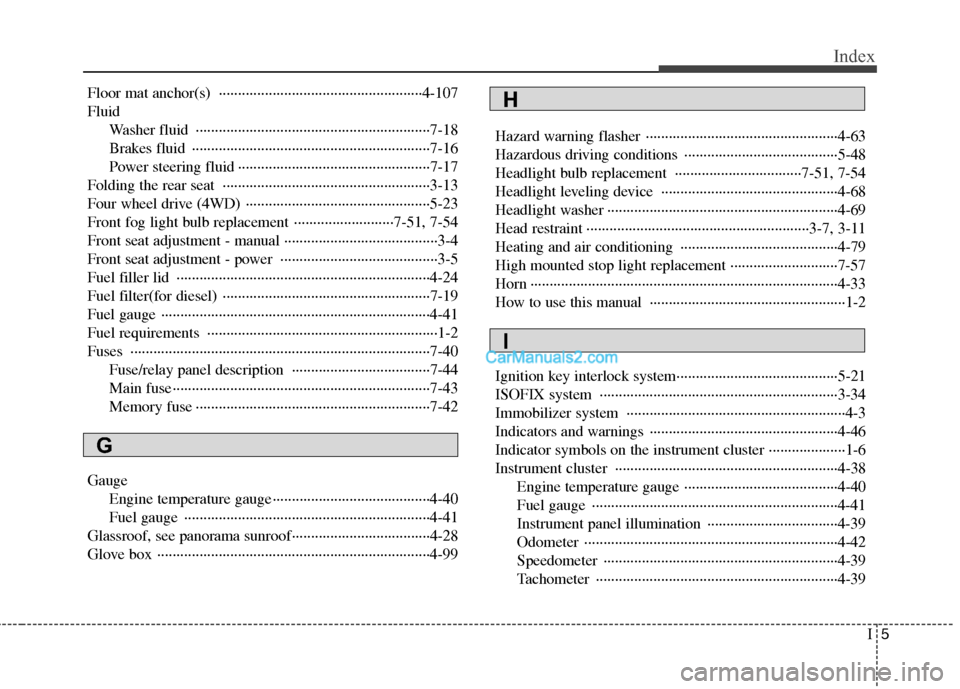
I5
Index
Floor mat anchor(s) ·····················································4-107 Fluid
Washer fluid ·····························································7-18
Brakes fluid ······························································7-16
Power steering fluid ··················································7-17
Folding the rear seat ······················································3-13
Four wheel drive (4WD) ················································5-23
Front fog light bulb replacement ··························7-51, 7-54Front seat adjustment - manual ········································3-4
Front seat adjustment - power ·········································3-5
Fuel filler lid ··································································4-24
Fuel filter(for diesel) ······················································7-19
Fuel gauge ······································································4-41
Fuel requirements ····························································1-2Fuses ··············································································7-40 Fuse/relay panel description ····································7-44
Main fuse···································································7-43
Memory fuse ·····························································7-42
Gauge Engine temperature gauge ·········································4-40
Fuel gauge ································································4-41
Glassroof, see panorama sunroof····································4-28
Glove box ·······································································4-99 Hazard warning flasher ··················································4-63
Hazardous driving conditions ········································5-48
Headlight bulb replacement ·································7-51, 7-54
Headlight leveling device ··············································4-68
Headlight washer ····························································4-69
Head restraint ··························································3-7, 3-11
Heating and air conditioning ·········································4-79High mounted stop light replacement ····························7-57
Horn ················································································4-33
How to use this manual ···················································1-2
Ignition key interlock system··········································5-21
ISOFIX system ······························································3-34
Immobilizer system ·························································4-3
Indicators and warnings ·················································4-46
Indicator symbols on the instrument cluster ····················1-6
Instrument cluster ··························································4-38
Engine temperature gauge ········································4-40
Fuel gauge ································································4-41
Instrument panel illumination ··································4-39Odometer ··································································4-42Speedometer ·····························································4-39
Tachometer ·······························································4-39
G
H
I